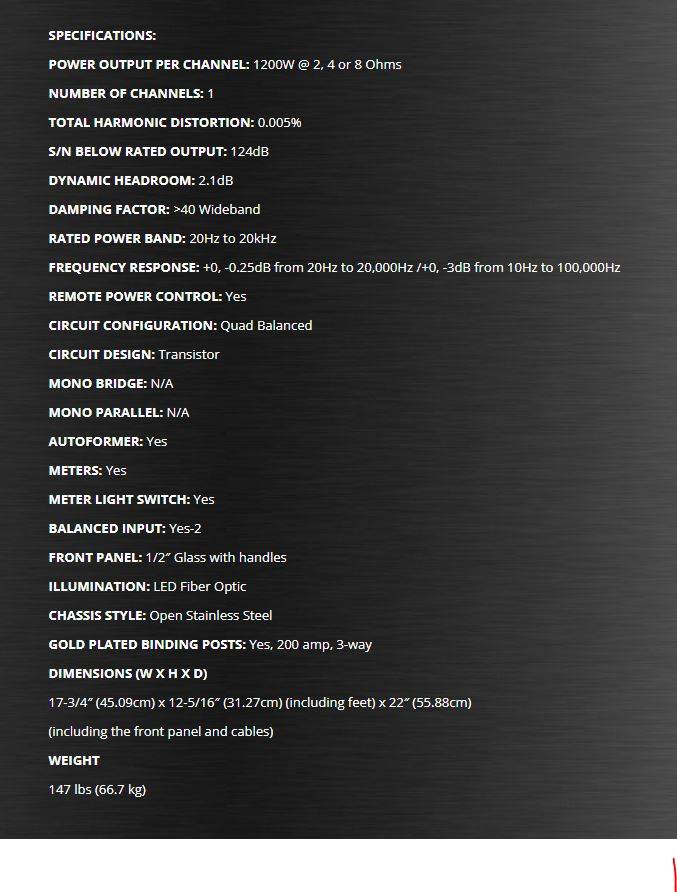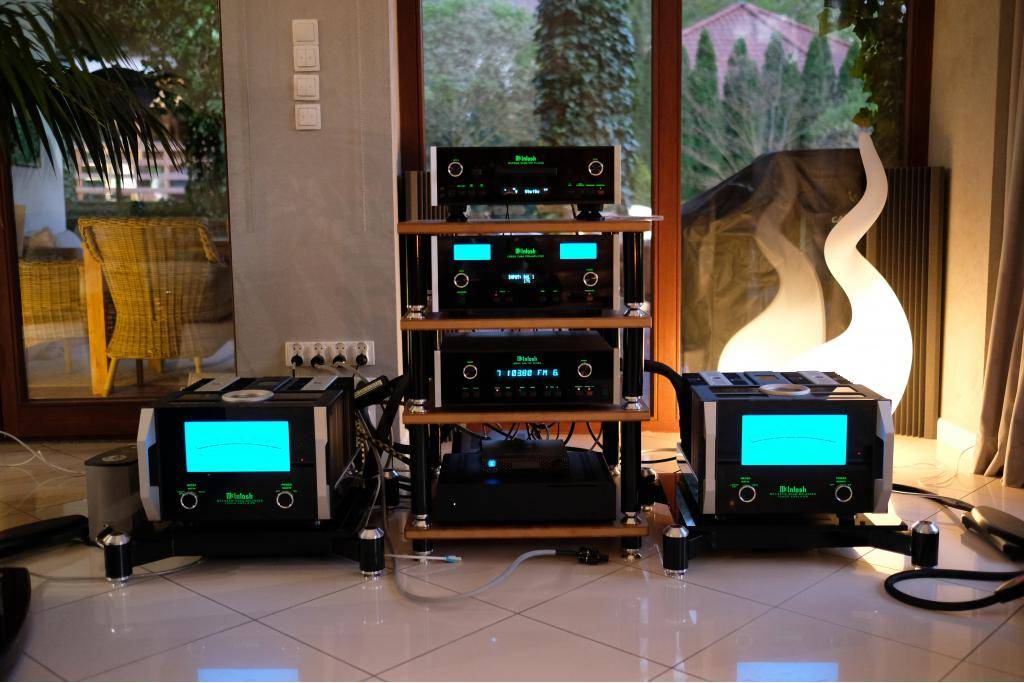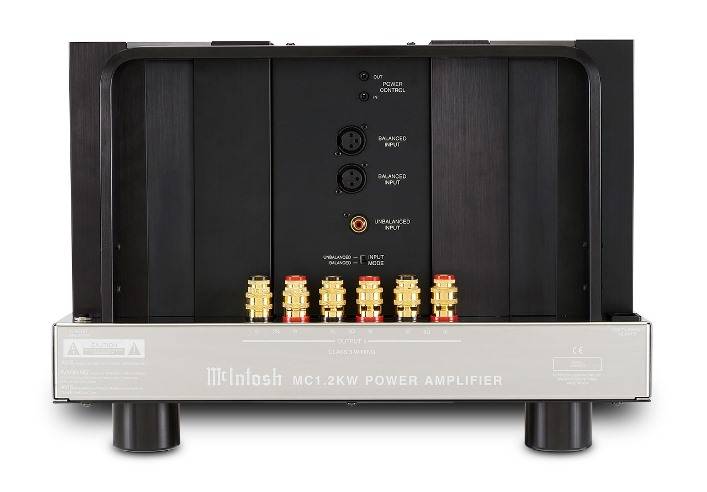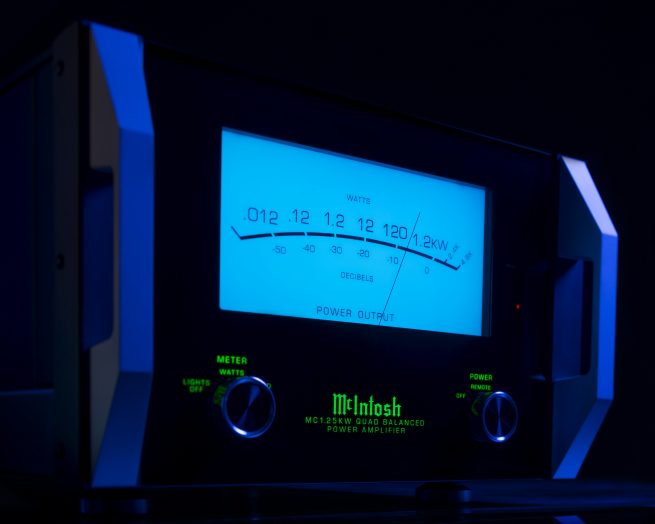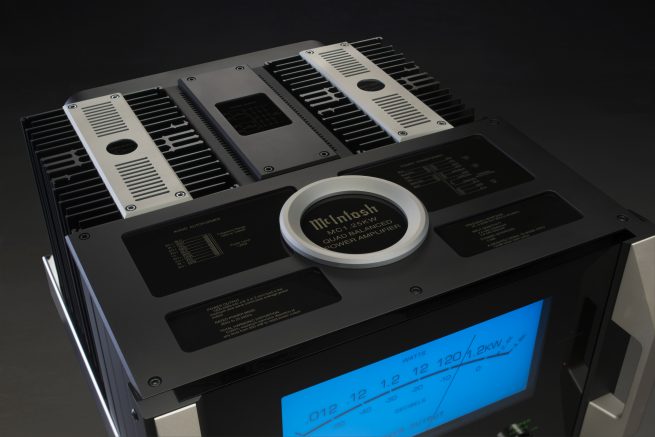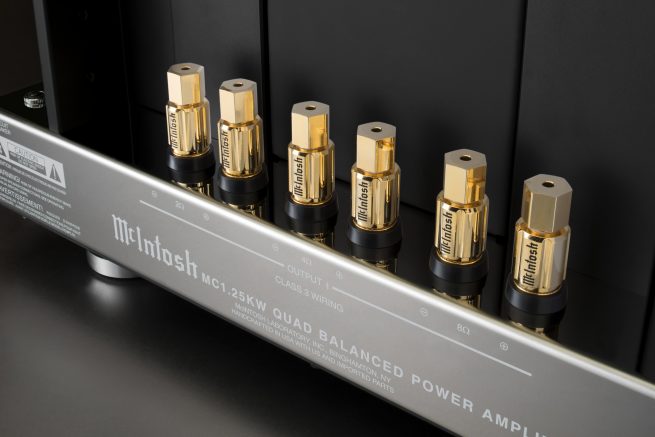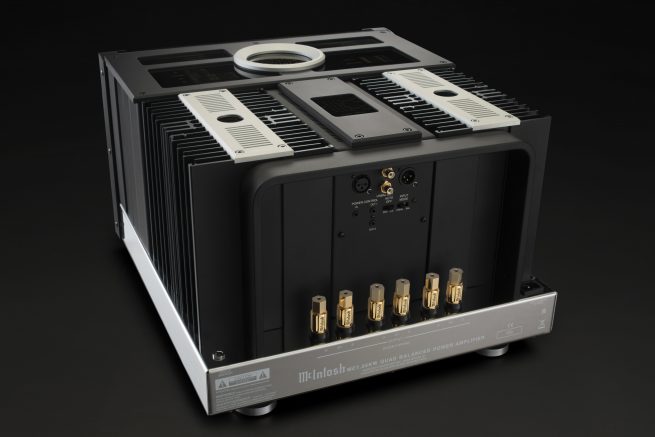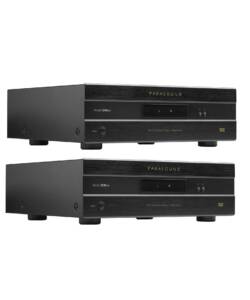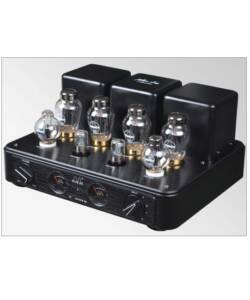McIntosh Laboratory MC1.2KW Mono Amplifiers
Original price was: R578,000.00.R330,000.00Current price is: R330,000.00.
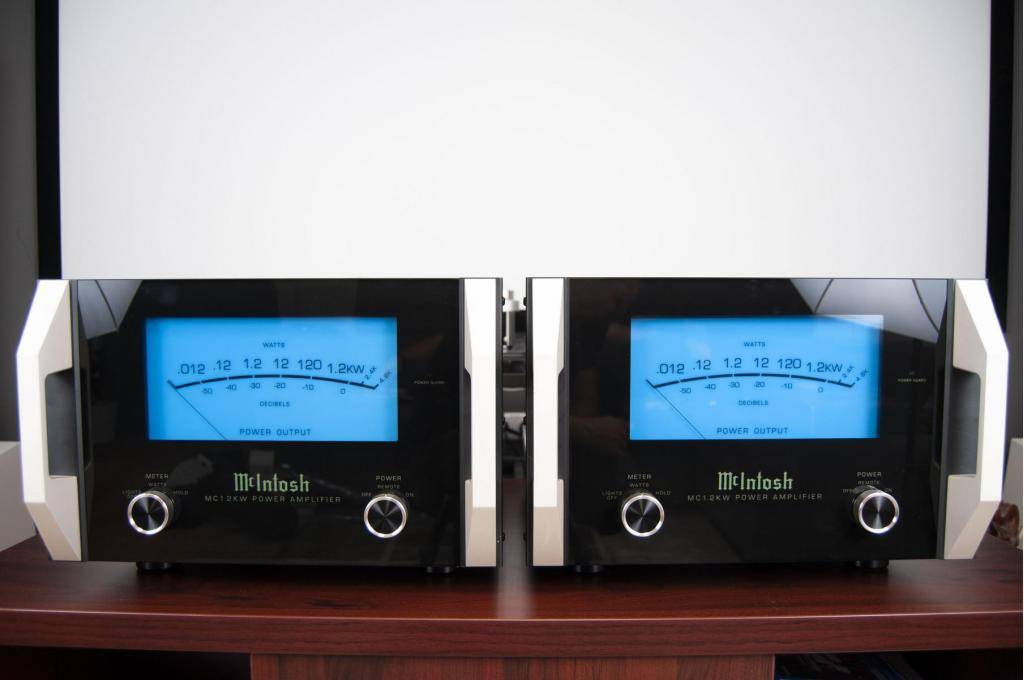
McIntosh made a big splash a while back with its six-box, 2,000-watt MC2KW power amplifiers. They are very cool, play incredibly loud (if you have enough juice in your power line to let them wind out all the way) and command an impressive presence.
Many lovers of the McIntosh brand see them as the Holy Grail. For those who don’t have the space or the budget but still dig those gigantic level meters, there’s a more reasonable alternative: the MC1.2KW. The more manageable MC1.2KW monoblocks tip the scale at only 147 pounds each. They’re still not budget components, but the $25k price tag will leave you with enough money left over from not buying the $70,000 MC2KW’s to assemble a formidable system.
Sporting metered faceplates the same size as the MC 2KW, the MC1.2KWs are attention getters. While many audiophiles love “deep-listening” sessions, nothing says “party on” like the gigantic blue meters, and this is a big part of their charm. Their blue glow floods your listening room like a couple of gigantic lava lamps. You can turn them off. But why?
A direct descendent of the MC1201’s, the MC1.2KW’s have significant electrical and cosmetic upgrades. According to Ron Cornelius, McIntosh product manager, the MC1.2KW “Actually produces closer to 1,600 watts per channel on a test bench, so you have to be careful with this much power on tap!”
Setup
Unless you are a super hero, getting at least one person to help you unpack the MC1.2KWs is a good idea. And be certain that your equipment rack can support at least 150 pounds per shelf.
Thanks to the large lip on the back, they are surprisingly easy to grasp and move around. I wish more manufacturers would provide rear panel handles on amplifiers this heavy.
While not the latest word in aesthetics, a pair of piano dollies come in handy shuttling the MC1.2KW’s between my reference amplifiers, along with the other gigantic amplifiers we had in for review this issue. They’ve since taken up permanent residence on a pair of Finite Elemente amplifier platforms and look very stylish; they beg to be displayed prominently.
Your next concern will be power. These big beasts need a lot of juice to do their thing. You can run a pair on a single 15-amp circuit, but they won’t reach full power. A dedicated 20-amp line
is better, but if you want an effortless 1,200-watt-per-channel experience, you’ll need a pair of 15-amp dedicated lines. McIntosh tech-support head Chuck Hinton recommends, “Each amp needs its own 15-amp line for maximum performance.” While McIntosh lists the maximum current draw at 13 amps, there’s no point in scrimping if you’re getting dedicated power lines run. Go for 20 amp lines and make sure to have it done by a qualified electrician. Ron Cornelius adds a few more tips, stressing the idea of having your wiring in top shape. Double check your power panel’s grounding and make sure all the connections to the panel and outlets are tight. It’s the nature of solid-core copper wire to wiggle loose with time. “If you don’t have solid power going to your system, your line level components will suffer as well.”
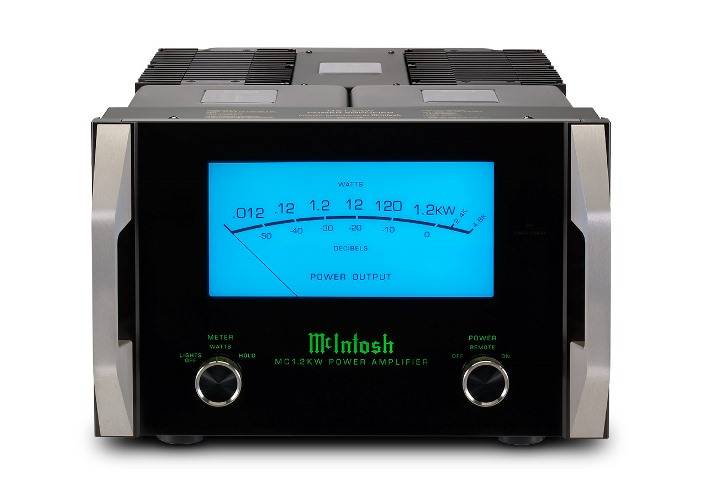
Extended listening with a dedicated 15-amp circuit, a dedicated 20-amp circuit, and dedicated 20-amp circuits for each monoblock reveals that power is your friend. While the amps worked with the single 15-amp line, the circuit breaker blew repeatedly at high volume.
The rest is easy. MC1.2KWs have balanced XLR inputs on the back panel along with RCA inputs and a 12-volt trigger, so it will integrate into any system handily. Due to the use of the legendary McIntosh Autoformers in the output stage, featuring 2-ohm, 4-ohm and 8-ohm taps to connect your speakers. Mc suggests starting with the nominal impedance of your speakers, but a bit of experimentation will yield the best results – sometimes the best match that transfers the most music might be a different tap. My only complaint with the MC1.2KWs, and for that matter all of the McIntosh solid state amplifiers are the dreadful speaker binding posts – they are too small and too close together.
The Sound
The MC1.2KWs immediately take charge. After a few hours warm up with nondescript background music, dropping Joe Harley’s recording of Mighty Sam McClain’s Give it up to Love threw a massive soundstage between my speakers. This record was recorded live to two-track analog tape and when you crank this one up and dim the lights, it sounds like mighty Sam is right there in your listening room (singing in front of a pair of gigantic McIntosh amplifiers in this case…).
With this kind of power at your disposal, big dynamic range helps to create a live feel on recordings with a big dynamic swing and the big Macs never disappointed, whether listening to a full symphony orchestra or Rammstein. You don’t realize just how wimpy your 100-watt per channel amplifier is until you have 1,200 per channel at your disposal. Trust me, you might never want to go back.
Friends listening to my system with the MC1.2KW’s always made the same comment: “Wow, I can’t believe how often those meters jump up around 300-600 watts and we’re not listening that loud.” All the arguments about “tube watts” vs. “transistor watts” vs. “whatever other watts you got” go away, and quickly. It’s big power vs. little power, baby, and if there was ever an argument for size mattering, the MC 1.2KWs settle the score handily.
People often forget that the need for power goes up exponentially as sound pressure level doubles; so that 100-watt-per-channel amp sounds great when you are listening in the one-to-10 watt range because you still have 100 watts or so in reserve, but when you get fast and furious with the volume control, compression sets in quickly and, if you’re not careful, clipping. Still, proceed with care when rocking out because even though it’s tougher to burn out a tweeter with all that clean power, you can run the risk of toasting a crossover when you are pushing the MC1.2KW’s near their limits. That’s when bad things happen to good people.
Power and Control
Next up, some Prince from the Diamonds and Pearls album. The beginning of the track, “Insatiable,” features deep synth bass lines with grunt that usually come across loose and sloppy. The extra power and control of the MC1.2KWs grabs those notes, holds the sustain and stops cleanly. I usually need the help of the JL Audio Gotham in my system to achieve that experience. No longer.
The other aspect of a high-powered amplifier that becomes instantly apparent is the ability to play complex music at relatively high volume levels without the soundstage collapsing. Try this with your favorite piece of densely packed music, whether it is a full symphony or driving rock. This is where the difference between 100 watts per channel and 1,200 per channel is instantly apparent. Though both play fairly loud, when you start to crank the 100-watt amp, everything gets muddy and you lose focus.
If you become the happy owner of a pair of MC1.2KWs, this will be a thing of the past and you might even discover that some of those discs that you thought were compressed just had their peaks rounded off.
During the course of this review, I had the opportunity to use the MC1.2KW’s with about a dozen different loudspeakers, from the Martin-Logan CLX electrostatics to the YG Acoustics Anat II Studios, both of which have low impedance dips and can be problematic to drive. Nothing in my speaker arsenal requires more power than my Magnepan 1.6’s Should you be a Magnepan owner looking for the Holy Grail, nothing lights up a pair of Maggies like the MC1.2KWs. Where the 1.6’s always feel somewhat bass shy in my 16 x 24 foot room, with the Mac amps they sounded like I had added a subwoofer to the system.
The dynamics were amazing and again, all who listened were surprised how easy it was to use up 1,000 watts per channel. It’s worth mentioning that no matter how hard I pushed these amplifiers, even when driving the Magnepans very loud, the MC1.2KW’s never got more than slightly warm to the touch.
Having just spent time with the MC252 amplifier that we reviewed very favorably, the MC1.2KW’s are in a completely different league. The MC252 is an excellent amplifier and a great value, but it does not have the delicacy and clarity that the MC1.2KW has. No matter what the listening level, these are some pretty special amplifiers with the slightest bit of warmth and body to the overall presentation. I doubt that anyone will ever refer to these amplifiers as “sterile solid-state.”
Big Power, Big Meters, Big Fun
At $25,000 a pair, this is not an idle purchase, even for the well-heeled. But if you want a pair of amplifiers that will never run out of juice or require you to buy a futures contract on output tubes, the MC1.2KW could be your Holy Grail. So dim the lights, put your favorite disc on and let em’ rip.
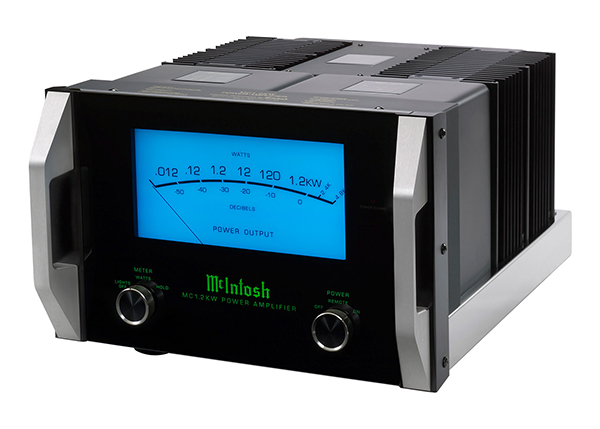 The McIntosh MC1.2KW Monoblocks
The McIntosh MC1.2KW Monoblocks
$24,995/pair
McIntosh Laboratory MC1.25KW Mono Amplifiers
- Written by Aron Garrecht
For the past few years, McIntosh Laboratory has been refreshing and expanding its product line at an unprecedented pace. The subject of this review, the MC1.25KW mono amplifier ($12,500 USD each), made its debut in late 2017, and I haven’t been able to take my eyes off it since. Imagine my elation when Mark Christensen, McIntosh’s marketing coordinator, offered to send me for review a pair of MC1.25KWs and their flagship preamplifier, the C1100 (review in the works). In discussions with Christensen, I learned that the MC1.25KW is both a replacement for and an evolution of McIntosh’s beloved MC1.2KW amplifier, and offers more dynamic headroom, upgraded parts and connection points, and refreshed industrial design and lighting.
Description
As was the MC1.2KW in its day, the MC1.25KW is now McIntosh’s most powerful single-chassis monoblock. Measuring 17.75”W x 12.3”H x 22”D, this 158-pound behemoth can produce 1200W of continuous power into 2, 4, or 8 ohms, with bursts of peak power in excess of 2kW. Equally impressive, and perhaps even more important, the MC1.25KW has a specified total harmonic distortion of just 0.005% and a signal/noise ratio of 124dB (balanced operation). It should make about as much noise as a block of granite sitting on a velvet pillow.

The visible differences between the MC1.2KW and MC1.25KW are many yet subtle. On the top panel, directly behind the glass faceplate, are two new glass-topped enclosures: the one on the left displays printed information for the autoformer, the one on the right information for the power transformer. Between these, the brand and model number are displayed on a circular glass plaque surrounded by a chunky aluminum rim. Toward the rear are two pairs of large aluminum heatsinks that run the full height of the amp and are cast to form the “Mc” monogram. The two sinks of each pair are capped and joined by a thick aluminum ventilation plate finished to match the trim ring and front grab handles.
The front of the MC1.25KW is largely unchanged from the MC1.2KW, with the exception of new LED lighting with improved distribution of light. The glass covering the 11” blue wattmeter remains 1/2” thick, but now, for greater precision, is UV-cured with high-resolution print instead of the silk-screening used on the MC1.2KW. On the faceplate are two knobs, each with three positions: the Meter knob, at left, can be set to Lights Off, Watts, or Hold, the last position telling the meter’s needle to remain at the maximum output; the Power knob, at right, can be set to Off, Remote, or On. Between these knobs are an illuminated McIntosh logo and the Power Guard and standby indicators, and outside the knobs are the faceplate’s aluminum endcaps and handles.

Around back are three pairs of McIntosh’s new, patented, Solid Cinch speaker binding posts, and an IEC power receptacle whose new position (relative to the one on the MC1.2KW) makes it possible to use bigger power cords. All of these are vertically oriented. I’m no fan of vertical power inlets — they’ll be torqued and strained by the weight of whatever power cord is used — but my large Clarus Crimson cords had no trouble fitting, and the connection was solid. What I did like was that the MC1.25KW has both balanced and unbalanced inputs and outputs, making bi- or even triamping a snap. These ins and outs, at top center of the rear panel, can also be used to pass along input signals to a subwoofer or another system. Directly below them are 12V power-trigger ins and outs, an auto on/off sensor, and a balanced/unbalanced toggle. The case is made of stamped and polished stainless steel, and rests atop four damped feet of new design with attractively chamfered profiles.
The MC1.25KW, like the MC1.2KW, is Quad Balanced — that is, its circuitry is fully balanced from input to output. Twin matched 600W amplification stages operate in push-pull, their outputs combined by an autoformer. The autoformer, designed to provide DC protection and to ideally match the amplifier output stages to a speaker load of 2, 4, or 8 ohms, works in harmony with McIntosh’s Quad Balanced architecture. This unique Quad Balanced design, I’m told, makes it possible for an amplifier to produce very high power output with very low levels of noise. While that sounds great in theory, I’ve always wondered how it works. I did a little research; here’s what I learned:
Quad Balancing sends the same signal down two identical amplifier signal paths in each channel of an amplifier. In the case of the MC1.25KW, the same monaural audio signal is fed to two 600W power modules, but one signal is inverted: its waveform rises where the original signal’s waveform falls, and vice versa. The two signals, inverted and noninverted, then enter the autoformer, whose dual coils are wound in opposite directions; as the inverted signal travels through the autoformer, it’s reinverted, restoring it to its original form — and simultaneously, the noise produced by each amplification module is canceled out. The clean power from both modules are then combined to perfectly double the power output.

McIntosh’s Quad Balanced architecture was used in the MC1.2KW. New in the MC1.25KW are upgraded circuit components, heavier-gauge internal copper wiring, an updated power transformer, new precision metal-film resistors, and new film capacitors. The MC1.25KW also has 50% more energy capacitance: a total of 162,000µF, or 450 joules. This not only helps provide more control over power-sopping low frequencies, it’s claimed to boost the MC1.25KW’s dynamic headroom by 0.2dB over the MC1.2KW, for a total of 2.2dB. McIntosh has also replaced the transistors used in the MC1.2KW with more advanced, higher-current output transistors selected for their ability to help “eliminate thermal equilibrium lag,” and which are directly connected to the newly designed heatsinks. These new transistors are ON Semiconductor’s ThermalTraks, which permit instantaneous monitoring of transistor temperature.
No McIntosh amp would be a McIntosh amp without a host of features designed to protect it and lengthen its working life, and the MC1.25KW gets the royal treatment, beginning with a new power-management system. This feature, which can be defeated by flipping a toggle switch on the rear panel, monitors the input signals and switches the amp into standby mode after having detected no signal for 30 minutes. In standby, the MC1.25KW draws just 0.5W. The MC1.25KW is also equipped with McIntosh’s time-proven Power Guard technology, which prevents it from being driven into clipping, and works with McIntosh’s Sentry Monitor thermal-protection circuitry, which protects the output stages from overheating.
Setup
Setting up 316 pounds’ worth of monoblocks is a labor of love, but thanks to the MC1.25KWs’ handy handles and thoughtful packaging, I could have done it unaided. Luckily, I had help, but nonetheless applied the KISS principle and placed these bruisers on a pair of butcher-block amp stands sitting on the floor.

Once they were in place, hookup was a snap: I removed the interconnects that usually feed my reference Simaudio Moon Evolution W-7M monoblocks and plugged them into the MC1.25KWs. My Audio Research Reference 6 preamplifier, PS Audio DirectStream DAC, Torus AVR 20 power conditioner, and Paradigm Persona 7F speakers all remained in place, and all was connected with Kimber Kable balanced interconnects and speaker cables and Clarus Crimson power cords. Also on hand and awaiting review were McIntosh’s C1100 preamp and EMM Labs’ DV2 DAC.
Easy on the ears
Having recently reviewed Merrill Audio’s Element 118 monoblock amplifier ($36,000/pair), I expected to hear a tonal shift with the McIntosh MC1.25KWs, and I did. The Element 118 is an exceedingly neutral, transparent, and revealing amplifier; in many ways, it’s a reviewer’s dream amp. The McIntosh MC1.25KW’s sound was warmer, richer, smoother — in short, not quite as tonally balanced. Nonetheless, I found the MC1.25KWs’ sound to be compellingly indulgent overall. But in stark contrast with the Element 118 — an amplifier whose sound I find to be uncolored until I push it very hard — it was clear that McIntosh has engineered the MC1.25KW to sound better than the MC1.2KW, yet maintain a degree or two of McIntosh’s traditional house sound.
Katie Melua’s voice in the title track of her Call Off the Search (16-bit/44.1kHz FLAC, Dramatico) sounded surprisingly similar to what I’d heard through the Element 118s and my reference Simaudio W-7Ms: clean, detailed, and articulate, with a level of realism that would be welcome from any amp. Nuances, however, such as the decays of producer Mike Batt’s piano notes and the thrums of Melua’s guitar strings, were more difficult to hear than I’m used to with my W-7Ms, and were entirely absent in comparison to what the Element 118s lay bare. It was as if everything above about 5000Hz had been rolled off by 1-2dB. On the other hand, I loved the weight and depth of Tim Harries’s bass guitar, and Melua’s dynamic vocal inflections were on a par with both other pairs of amps — and a noticeable improvement over what I remember hearing from the MC1.2KWs.

Listening to “Man in the Long Black Coat,” from Bob Dylan’s Oh Mercy (24/88.2 FLAC, Columbia), I quite enjoyed watching the thin black needles of the Macs’ meters bounce around to the expertly reproduced plucks of Dylan’s acoustic guitar. As I raised the volume, I was amused to see those once-lively needles suddenly peg at the -40dB mark, when Tony Hall’s deep and resolute bass enters. The control over each note exhibited by the MC1.25KWs was as resolute as it was ground-shaking, and despite the sound levels approaching the upper limits at which I normally listen, I got the distinct impression that these amps had only begun to approach the output level at which they like to operate. So I drove them harder, pushing the needles up to 120W and beyond. I soon realized what these big Macs are all about: unrelenting power.
Only one other amplifier I’ve reviewed has ever instilled in me the confidence that the MC1.25KWs did, and that was Simaudio’s Moon Evolution 888 monoblock, at nearly five times the price. The 888s were not only the most powerful, but also the quietest amps I’d ever reviewed. In the opening seconds of “Man in the Long Black Coat,” in which only one instrument plays against an ink-black background, I again “heard” a noise floor so low it was almost inaudible. In fact, the MC1.25KW’s specified signal/noise ratio of 124dB is 4dB quieter than the monster Moon’s. Realizing that the MC1.25KWs seemed to sound better the harder I pushed them, I played “Born Slippy,” from Underworld’s live album Everything, Everything (16/44.1 FLAC, JBO), and was taken back a decade, to when I saw this band perform in Toronto. I adjusted the volume to a level commensurate with what I remember hearing at that concert, and reveled in the sound of applause in the background against Karl Hyde’s voice and the rhythmic, punchy beat of the drums. As soon as I heard the repetitive synth notes that define this song, which originally appeared on the soundtrack of Trainspotting (1996), I couldn’t help but close my eyes and reminisce in an inner fog of nostalgia. Still a hint reserved in their reproduction of upper-frequency nuances and spatial cues, the MC1.25KWs were the antithesis of slow or laid-back with “Born Slippy,” “Cowgirl,” and “King of Snake.” Bass notes absolutely thumped. As I moved on to other electronic tracks — e.g., “Serendipity,” from Armin van Buuren’s A State of Trance (16/44.1 FLAC, Armada) — I appreciated the absence of the glare and varnish I hear with more uncompromisingly revealing amplifiers such as the Merrill Element 118s and, to some extent, even my Simaudio W-7Ms.

When I switched gears and listened to an SACD rip of “So Far Away,” from Dire Straits’ Brothers in Arms (24/88.2 FLAC, Vertigo), the rich, fulsome sound of the MC1.25KWs was again fully displayed. In the opening seconds, the cymbal taps in the left of the soundstage were well delineated, with fast transient control. Omar Hakim’s thwacks of the drum skins were fast and dynamic, with just a hint of decay, and his kick drum was convincingly punchy and impactful. As Mark Knopfler chimed in on electric guitar, nothing seemed to be missing, and the aural image of each instrument was depicted on a deep, wide soundstage, just as it should be. The tambourine taps at right center weren’t quite as present as I’m used to hearing, but still had a subtle shimmer, and were defined well enough that I could hear individual zills.
As that track ended and “Money for Nothing” began, I again succumbed to the urge to pump up the volume. As the Macs’ needles bounced around well past the 120W mark and items on nearby walls rattled, I couldn’t help grinning. The volume was as high as I dared push my Paradigm Persona 7F speakers, and the sound simply grew in volume, scale, and intensity — there was no compression of soundstage or diminution of three-dimensionality or inviting tonality, nothing sounded shrill or varnished, the amps’ control of bass notes didn’t diminish, and there was no lack of depth or impact to that grin-provoking bass. As the sound filled my room, everything was just . . . louder. When I’ve occasionally pushed my speakers this hard with the Simaudio W-7Ms I’ve heard much the same quality of sound, but with a hint of glare that inevitably prompts me to soon ramp the volume back down. And when I pushed the Merrill Element 118s this hard, their sound became bright, quickly leading to listening fatigue.
The fact that the MC1.25KWs sounded a bit more relaxed at lower volumes is assuredly the reason they were able to play so loud while remaining inviting. Typically, when someone tells me a product sounds “relaxed,” I assume they mean that it sounds dull or boring. That wasn’t the case with the MC1.25KWs. Proportionate to its lack of micro-level detail, there was greater image focus, specificity, and body. Music, regardless of genre, was presented with ease and a silk-smooth refinement, yet this amp’s pace, rhythm, and timing were spot on.

And I was beguiled by the MC1.25KW’s reproduction of bass. At low volumes, there was a sense of weight, kick drums were punchy, and notes were articulated, transparent, and tonally accurate enough that I could easily discern the differences among electric, synth, and double basses. I don’t hear this level of resolution from my reference monoblocks, because at lower levels there simply isn’t enough bass volume for me to do so. At moderate volume levels, the weight, punch, and dynamic drive of the MC1.25KW grew in scale and articulation, and this control and body is maintained even at outlandish listening levels, much as I heard from Simaudio’s Moon Evolution 888. Male and female voices were consistently vivid and intricately communicated, which goes a long way toward implying that the requisite level of detail is there, even though it isn’t. I suspect that, without a more resolving pair of amplifiers sitting right next to the MC1.25KWs for instant comparison, some listeners might not notice that anything at all is missing.
Summing up
McIntosh Laboratory’s MC1.25KW monoblock amplifier sounds absolutely beautiful. It could communicate just a bit more top-end inner detail, but its lush, sophisticated sound is also part of its allure. Physically, the MC1.25KW represents one heck of a value for $25,000/pair. It is expertly engineered, skillfully assembled, full of top-quality parts, and made of some of the best materials available. If you believe that an amp is an amp and that all amps sound the same, compare the MC1.25KW directly with whatever other monoblocks you deem, well, comparable. I guarantee your paradigm will be shattered. Enthusiastically recommended!
Steel fist in silk gloves
With divine power and control, McIntosh-amplifiers control most speakers.
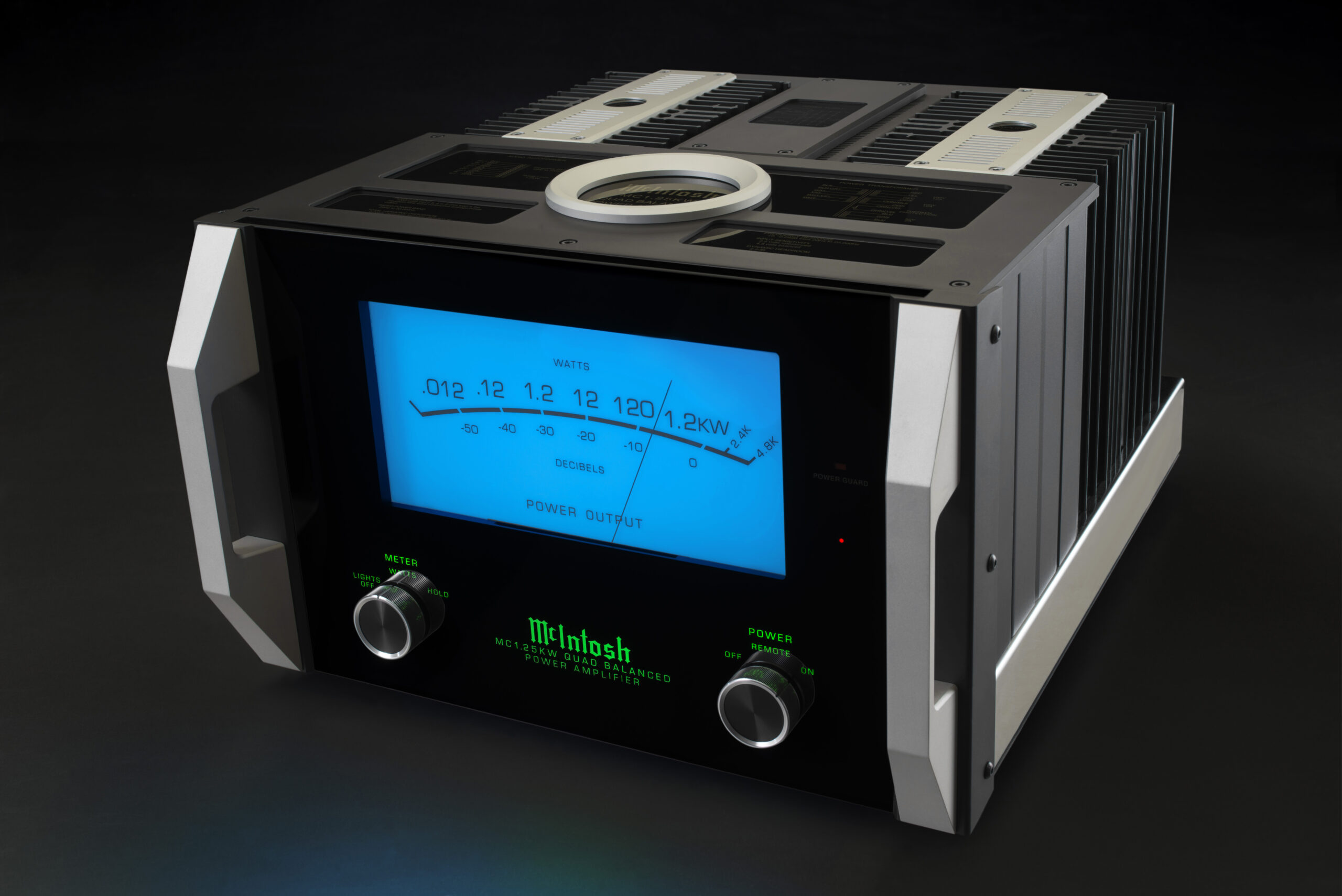

Specifications
Type: Mono power amplifier
Effect: 1 x 1200 W 2/4/8 ohm
Technology: Transistor balanced quad
mono circuit
Connections: 1 x unbalanced,
1 x balanced input
Frequency response: +0, -3dB,
10Hz – 100,000Hz
Dynamics: 22 dB headroom
THD: 0.005 %
Signal/noise: 124/120 dB, balanced/
unbalanced
Other: Illuminated VU meter, wired remote control
Dimensions and weights: 45 x 31 x 56 cm/71.7 kg
Website: neby.no
Little compares to the powerful dynamic control and the bottomless bass that a real power amplifier possesses.
Although it borders on overkill for most of us, not to mention most speakers, there is something special about the sound of a powerful, 1200 W amplifier.
Just like a super car, you are not prepared for a low rpm with the pedal to the metal. Crank up the sound two extra notches, and expect to be knocked back into your easy chair, which even the most expensive amplifiers barely manage to do.
Unless, that is, they have as much power as the McIntosh MC1.25KW.
With 1.2 kW at our disposal, no matter what kind of speakers you have, there is so much going on that your ears – and the speakers – give up long before the amplifier even gets warmed up.
To understand it, you have to try it.
McIntosh’s new 1200 watts succeeds the already legendary MC1.2KW, and most of it is seemingly similar here. But just the outside, and just barely.
The basic recipe is the same. Two outrageously huge transformers are the heart of a massive power supply, which via a comprehensive condenser battery supplies powerful output transistors with endless power. As usual, it uses the Autoformers – transformers – on the outputs, which renders the amplifier immune to different speaker loads.
But all the circuitry, components, power supplies – even the heat sink, are new on the MC1.25KW.
Everything is controlled by a microprocessor, which uses Power Guard circuits to curb clipping of the signal, and the Sentry Monitor that protects output circuits. It disconnects the amplifier to avoid a short circuit if the load becomes too large. This won’t happen here.
Construction
With a match weight of over 70 kilos apiece, and the size of a small freezer, they take up space. But they don’t become very hot, and you can connect them with a cable to a McIntosh preamp so that you don’t have to turn the amplifiers on and off. Everything is controlled with the remote control to the amplifier.
On the flip side, there are inputs and outputs for connecting to preamplifiers, and outputs for an extra power amplifier, if one would want to connect several MC1.25KW in a bi-amp solution.
At my house, the MAC was connected to a 16A rate that is only used for the system. But every time I turned on the system with the remote control for a MC2600, the fuse blew. The solution was to unplug the remote control from the preamplifier and turn them on individually.
Refined and brutal
Possibly the best I’ve heard
On our reference monitors from Dynaudio, Contour 20, it was quickly evident that the amplifiers represent the new generation McIntosh-amps.
The same appealing warmth, the lush tone of the mid-range, and the heavy bass, is just like on the MC1.2KW. But the new edition sounds fresher, better resolve, tighter and more airy. There are several tone colours and shades in the music with MC1.25KW in the system.
The much larger floorstanding Burmester B18 opened up the soundscape even more compared to the C20, and has a larger range in the bass. With the B18 connected, the scale of the music also naturally grew. Paul Bley’s album in The evening Out There, with Gary Peacock, Tony Oxley and John Surman (ECM), gained an astonishing realism with the Macs and B18.
There’s something about the way the amplifiers present the deepest tones of double basses, drums and pianos that gives the music a far more credible foundation. It’s something that most bigger McIntosh amps are good at, but none of them do it the same way as these.
Portrait Of A Silence starts with a long double bass solo that shakes the core when playing loudly. Even on the small C20, you feel the bass in your diaphragm, but what really impresses is how incredibly nuanced the whole thing sounds. At the same time, the control and dynamic contrast is outstanding. Perhaps the best I’ve ever heard.
Goodnight Rose from Ryan Adam’s Easy Tiger, I have never heard it as crystal clear completely without distortion, and at the same time so controlled before and at such high volume. The drums are rendered far more physically than I am accustomed to, and I cannot think of any amplifier that can come close to playing this complex music so effortlessly to such a degree.
At the same time, it is not devoid of finesse and sophistication. Mozart’s The Magic Flute followed by Cosi Fan Tutte, sparked renewed interest in Mozart’s operas simply because there is an outstanding organic and ultra-resolved soundscape that releases so much more of the underlying nuances so that the music comes much closer to the listener.
I haven’t heard anything like it.
Conclusion
Few loudspeakers require 1200 from the amplifier, and it’s not about top speed here, but rather control. McIntosh MC1.25KW has this in great abundance. It is brutal and refined at the same time, with an unprecedented ability to project even more dynamics, although one might believe that the ceiling had been reached. It never loses its grip, perhaps with one exception: if one combines a very demanding speaker with a room far too large. If you want dynamic control, the finest nuances and are afraid of running out of power, this is the amplifier you should own.
Description
-
Winner of Stereo Sound Grand Prix 2017
-
Reference Award
-
Highly Recommended
